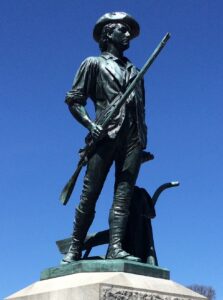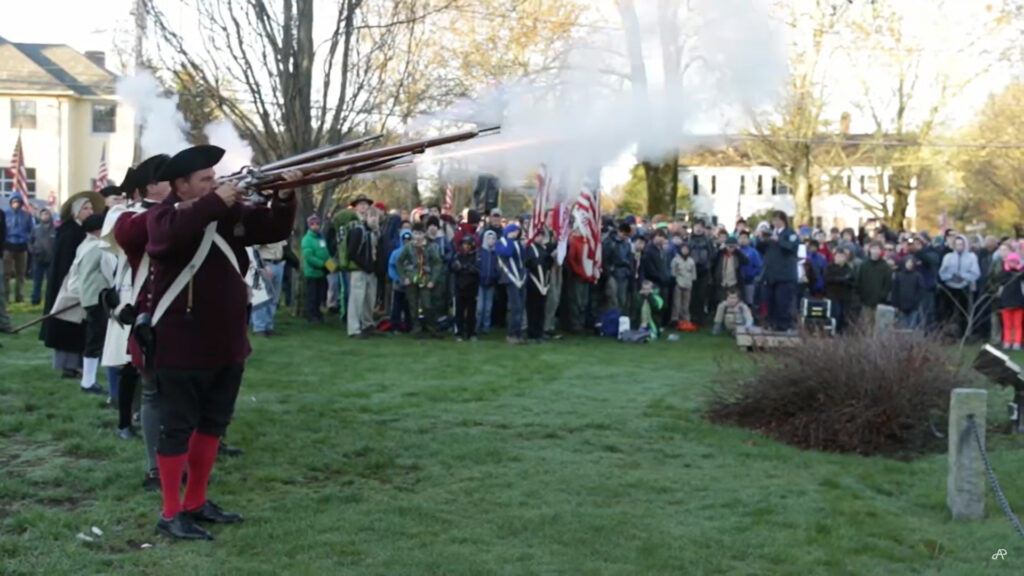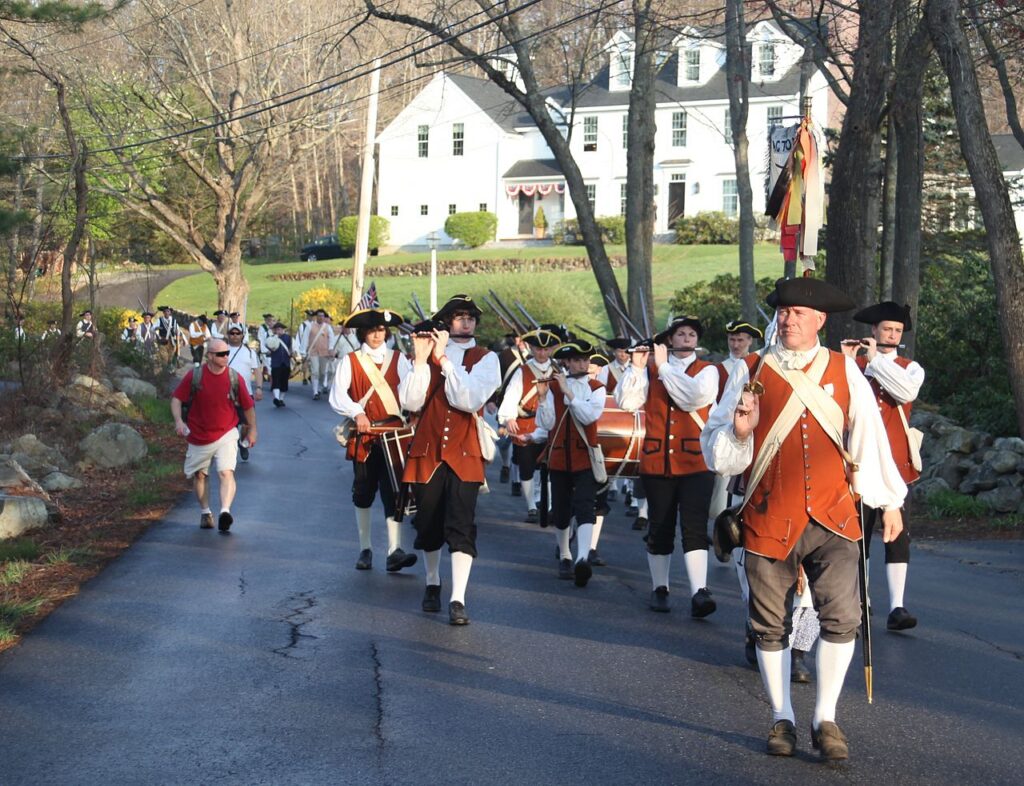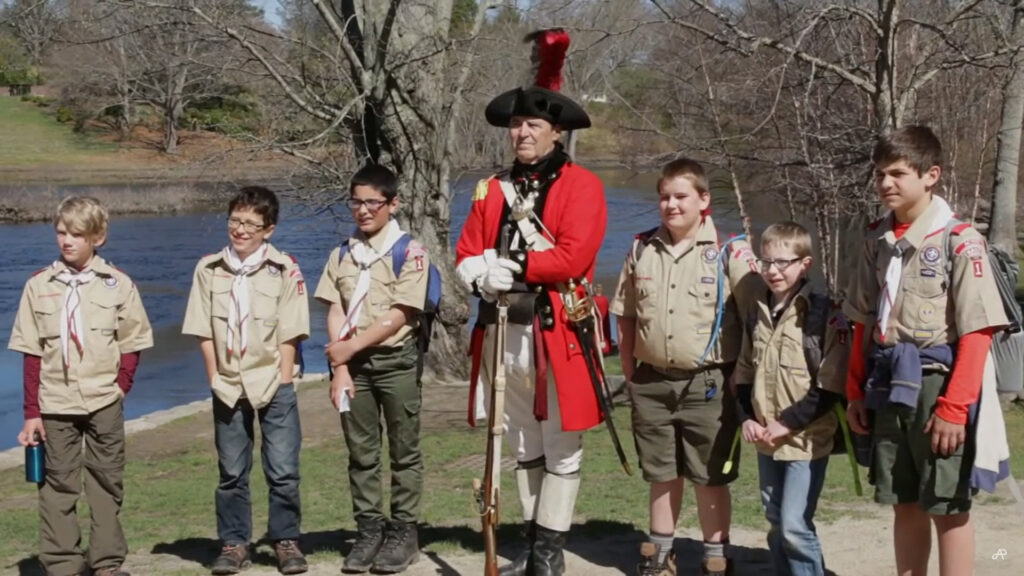History of the Isaac Davis Camporee and March
The Isaac Davis Story1
In 1775 Acton was a town of approximately 750 people. Within its bounds were two companies of militia and one of the Minutemen. In theory, the militia companies, under the command of Colonel Francis Faulkner and Captain Joseph Robbins, were under orders from the Crown. In practice, this had ceased to be true.
companies of militia and one of the Minutemen. In theory, the militia companies, under the command of Colonel Francis Faulkner and Captain Joseph Robbins, were under orders from the Crown. In practice, this had ceased to be true.
Davis’ minuteman company was particularly noted for its zeal. It met twice weekly for drill to the accompaniment of fife and drum. The fifer, Luther Blanchard, and the drummer, Francis Barker, often played “The White Cockade” and that tune became the recognized musical signature of the company. The company was also unusual in that all the muskets were fitted with bayonets, many of Davis’ own manufacture.
Throughout Massachusetts, military supplies were being accumulated by the colonists. The British in Boston under the command of General Thomas Gage, who was both military commander and Governor, were aware of this. Spies were sent out to discover the location of these stores, and British soldiers were frequently marched several miles out of Boston to the countryside. Since the colonists could never be sure whether the purpose of the march might be the capture of the supplies or just to “show the colors,” their apprehension mounted. Many colonists, particularly the minutemen, began carrying their muskets at all times.
Concord had become a center of colonial political activities since it was an inland center of the population just far enough from Boston not to be under the eye of the Crown. Minutemen and militiamen from neighboring towns met to muster in Concord, although the musters were sometimes more social than the military. In late March 1775, a second Provincial Congress met in Concord.
On the 15th of April Congress adjourned. No sooner had the delegates left than word was received of an impending British march on Concord. Couriers were sent to the surrounding towns alerting militia and minutemen that it might soon be necessary for them to provide a show of strength at Concord. The cannon and heavy supplies stored in Concord were hastily moved to neighboring towns. Tradition has it that the two brass mortars sent to Acton were hidden behind Captain Joseph Robbins’ house in what is now part of Woodlawn Cemetery.
The report of the impending march was accurate. On Saturday, April 15, 800 British regulars and marines were taken off regular duty for special maneuvers. General Gage, under pressure from England and local Tories, had decided to send an expedition to Concord to destroy the military supplies known to be stored there and to capture any colonial leaders who might be in the area. Through couriers, the colonists soon learned everything about the expedition except when it would arrive.
On the morning of the 18th, ten Redcoats were sent to patrol the road between Boston and Concord with orders to intercept any messengers bound for Concord. At ten o’clock that night the British expedition, each man supplied with one day’s food ration and ammunition, embarked in long boats across Boston Harbor to Lechmere Point. From there they waded through marshlands to begin the march to Lexington and Concord.
William Dawes and Paul Revere had been selected to alert the countryside when the march began. Dawes was to take the long overland route through Roxbury, Brookline, and Harvard Square. Revere was assigned to ride from Charlestown through Medford and Menotomy (now Arlington) to Lexington and towns west. Revere was rowed across Boston Harbor to Charlestown within sight of British warships. There he received the storied signal from the Old North Church belfry as to whether the British were taking the sea or overland route. Arriving in Lexington, Revere alerted Samuel Adams and John Hancock of their danger and persuaded them to flee. Half an hour later Dawes arrived and the two left to carry the alarm to Concord.
On the outskirts of Lexington, the two riders met Dr. Samuel Prescott, who was returning to Concord from a visit to his fiancée in Lexington. The three had ridden about halfway to Concord when they were surprised by the British patrol. Dawes, who was riding in the rear, almost managed an escape but eventually, the three were herded into a stone-walled field. At a shout from Prescott, the colonists made another try for freedom. As Dawes and Revere rode for the back of the field, Prescott spurred his horse for a leap over the wall and got away. It was Dr. Samuel Prescott who brought the alarm to Lincoln and Concord and to Acton and Stow.
Prescott’s first stop in Acton was at the home of Captain Joseph Robbins. He did not dismount, but pounded on the corner of the house and shouted “Captain Robins, Captain Robbins! The Regulars are coming.” He then raced on to alert Colonel Faulkner in South Acton and thence to Stow.
Captain Robbins rushed from the house with his musket and fired three shots as rapidly as he could reload. This was the signal for each Acton minuteman and militiaman to report to the home of his captain, armed and prepared to march to Concord. The alarm was picked up, and the sound of three musket shots could soon be heard repeated across the countryside. John Robbins, the Captain’s 13-year-old son, mounted the family mare and rode off to carry the news to Captain Davis and to Captain Simon Hunt who would be leading the Faulkner Company that day. Soon the volunteers began to arrive. At the Faulkner home, women gathered to begin the preparation of food to be carried to the men at noon by sons too young for military service.
Thirty-seven minutemen arrived at Captain Davis’ house before dawn on April 19, 1775, each outfitted with a musket and bayonet, powder horn, bullet pouch, and a ration of bread and cheese. Among them was James Hayward, Acton’s schoolmaster, who was not a regular member of the company, being exempt from military duty because of a foot injury.
The march to Concord began to the tune of “The White Cockade”.
The last time the minutemen companies had mustered in Concord, it had been on Concord’s common; but as Captain Davis and his men reached Barrett’s Mill Road, they were told that Colonel James Barrett, who was in general command of the militia at Concord, had ordered his men to the brow of Punkatasset Hill on the west side of the Concord River. The Acton Minutemen joined him there. As on muster days, the companies took up their positions: militia on the left, minuteman companies on the right facing the North Bridge.
In the meantime, the British expedition reached Concord. A raiding force was ordered to cross the Concord River at the North Bridge and continue to Barrett’s farm to burn supplies they had been informed were stored in the barn. While the colonists watched from their vantage point on Punkatasset Hill, seven companies of British regulars reached the bridge. Four of these companies crossed the bridge and proceeded via a causeway to Barrett’s farm, while the other three companies remained to guard the bridge.
Soon after the arrival of the Davis Company, the colonial officers called the first council of war in what was to become the American Revolution. Colonel Barrett was in command. Rumors of shooting and killing in Lexington were spreading, but the stories were confused and unverified. As the officers conferred, smoke was seen rising over the town of Concord. Thinking the British were setting fire to the town, the colonial officers decided to force a crossing of the bridge and save the town.
Colonel Barrett ordered Major John Buttrick to have an advance made over the bridge and into the town, but not to fire unless fired upon. Major Buttrick, needing a company to lead the march, turned to a Concord Captain who declined to lead. Buttrick then asked Captain Isaac Davis, whose company was the only one completely outfitted with bayonets, if he was afraid to go. Davis was heard to reply, “No, I am not and I haven’t a man that is afraid to go”.
Davis’ men marched down toward the bridge, accompanied by Major Buttrick and Lieutenant Colonel John Robinson of Westford. They were followed by three Companies from Concord, then the Acton Company under Simon Hunt, a Bedford company, a Lincoln company, and the Robbins Company from Acton.
As the colonists approached, the British guarding the west side of the bridge retreated over it, leaving behind a few men who began to tear up the planks. Buttrick shouted at them to stop and they fell back with their comrades to form for action. When the American column was about 160 feet from the bridge, the redcoats fired a few random shots. One ball creased the forehead of Luther Blanchard, the fifer, slightly wounding him and a Concord man in the ranks behind. At this, Major Buttrick gave the order to fire.
Only the Acton men were in a position to fire. As they lifted their muskets, a volley was fired by the British. Isaac Davis was killed instantly. Abner Hosmer of Acton was mortally wounded with a bullet through the head.
The volley returned by the Acton minutemen had killed one redcoat, fatally wounded a second, and wounded several others. The British retreated toward Concord, followed by a few colonists; but the colonists were disorganized. About 200 gathered on Ripley Hill to watch the British, but most of the others returned to the bridge. The bodies of Davis and Hosmer were carried up the hill to Major Buttrick’s home, to be taken back to the Davis home in Acton later that day.
The retreating British were reinforced by two or three companies coming out from Concord, but for the most part, there wasn’t any further fighting. When the British troops returned from their foray to Barrett’s farm, unaware of the action at the bridge, they were allowed to pass over the bridge untouched.
About 500 angry, armed colonists were now assembled at the muster field and more were arriving. By midmorning, it seemed to the British commander that his force might soon be outnumbered. His men had not slept the preceding night, and several were wounded. He ordered them back to the center of Concord. There was a delay as transportation was sought for the wounded, but by noon the march back to Boston had begun. It was too late, other minutemen and militia companies had arrived from more distant towns. The colonist now numbered almost 2000, all eager to get in the fight. As the British retreated, they fired on colonial companies at Meriam’s Corner. The fire was returned and from thereon it was continuous for the 16 miles back to Charlestown. At first, the regulars stayed on the road as their pursuers fired upon them from behind trees and stone walls. Finally, the British put flankers on either side of the road and these men were responsible for most of the colonial casualties of the day.
At Fiske Hill some redcoats entered the farmhouse for pillage. While they were there, James Hayward the lame schoolmaster of Acton, stopped at the well for a drink. He was surprised by a British soldier who stepped from the house, shouting, “you’re a dead man!” “And so are you!” replied Hayward. The men fired simultaneously: the regular to die immediately and Hayward some eight hours later.
At Lexington, the British were met by reinforcements from Boston. They pillaged and burned part of the town and killed some civilians before starting off again for Boston. But at Menotomy, they were attacked by about 1800 well-armed colonists and there suffered their greatest casualties of the day.
Thus end of April 19, Patriot’s Day as it is now celebrated. Ralph Waldo Emerson memorialized the first shot at the bridge as “the shot heard ‘round the world”. In local, more chauvinistic terms, the events of the day were characterized as “the battle of Lexington, fought in Concord, by men of Acton”.
1We would like to acknowledge our sincere appreciation and thanks to the Acton Historical Society, for their help in the preparation of this historical background of the Isaac Davis Trail.
The Rediscovery of the Trail in 1957 and the Modern March
In 1957, Acton’s Boy Scout Troop began a tradition that has now more than 50 years of hiking the original trail from Acton to Concord’s Old North Bridge.
The leadership of the Troop met at the home of Ivan Wold, the Scoutmaster on the last Sunday of each month to plan the coming month and schedule the next months’ Troop meeting and other events such as hikes and camping trips.
At the February meeting, we were looking for something to do during the school vacation which would occur in April. “I made a suggestion that we hike down to Concord and watch the Patriots Day Parade that was an annual event.” Mr. Wold was skeptical of this because the routes to Concord were well-traveled roads and were too dangerous. His wife, Dorothy, overheard our conversation and told us that she had walked to Concord in 1925 when the Town of Acton celebrated the 150th and the route that the walkers used did not involve any highways. If we were interested, she would research and see if it was feasible. Everyone present agreed that the idea sounded like a good thing to try out.
During the next few weeks, Mrs. Wold went to talk to various old acquaintances to determine the exact route that was taken in 1925. As her neighbor, she asked me if I wanted to go along with her and Mr. Oliver D. Wood and note the trail as they remembered it. Mr. Wood was a carpenter, well into his 80’s but in excellent physical and mental condition. He was born in Acton and knew all the parts of the old trail that had been largely abandoned for close to a century and a half.
Once the trail had been rediscovered, the next effort was to receive permission from the present owners of the property. Since the original road was essentially that of a way to the meeting house and does not include the Main Street portion between 1 Hayward Road and Nagog Hill Road, but passes behind the present Main Street.
Permission was received to use the Conant property as well since Brook Street was built later and the old road that aligns with Strawberry Hill Road. One portion of the trail was not used, that between Estabrook Road and Pope Road. The hikers would utilize Strawberry Hill Road between Great Road and Barretts Mill Road.
In Concord, we were also able to get permission to cross through several yards that placed us in position with the North Bridge at the Buttrick Property and the owners of the Butterick Estate also gave us permission to cross to the bridge.
With the owner’s permission behind us, a trial run was made on Sunday, April 14th, 1957 beginning at 1 p.m. We arrived in Concord about 2 hours later and figured that we would probably have to leave the Isaac Davis house at 6:45 to be at the bridge by 9 a.m. to see the beginnings of the parade.
The following Friday, we managed to leave the Davis house a little late. It was closer to 7 a.m. but we made the first hike to Concord in pretty good time. The weather was overcast, typical of a damp Spring day. We were lucky that the typical high water of spring had not arrived and we were able to make it to the bridge. One of the barriers that existed was an iron fence that surrounded the Minuteman Statue and we had to scale that. When we did get onto the bridge, we were met by Dr. Francis MacDonald, a local pediatrician. He informed us that because it was Good Friday, the Parade was canceled and that the only thing that occurred that morning was the presentation of Captain Isaac Davis’s sword by the Concord Selectmen to the Acton Selectmen.
Recollections by William A. Klauer
Troop Scribe in 1957
Links of Interest
History:
- History of Acton, Massachusetts [Wikipedia]
- Acton Minutemen Home Page
- Acton Historical Society
- History of Concord, MA
- Lexington Historical Society
- Battle Road
- Campfire Ashes


